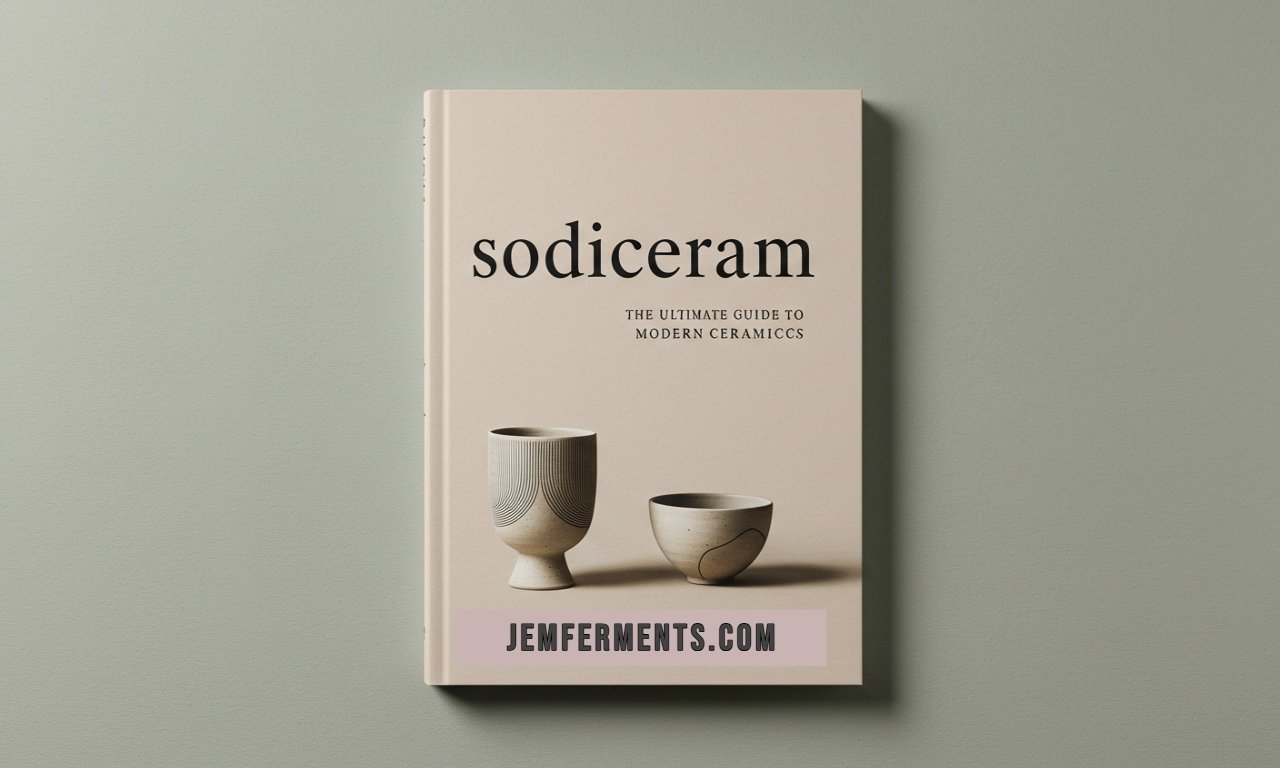Ceramics have always stood as a testament to human creativity, resilience, and design sophistication. In today’s world, sodiceram has become a recognized name associated with durability and style. Whether for residential projects or large-scale commercial applications, it represents the perfect blend of practicality and elegance. Architects, designers, and homeowners are increasingly embracing this option because it combines functionality with timeless beauty. With its ability to withstand daily wear and enhance spaces aesthetically, sodiceram is no longer just a construction element—it has evolved into a lifestyle choice.
History of sodiceram
The story of sodiceram is rooted in the broader history of ceramics. From early pottery fragments found in archaeological digs to the fine porcelain of dynasties, ceramics have traveled a long journey. Industrial revolutions introduced mechanical processes, leading to stronger and more uniform products. By the late 20th century, brands and manufacturers began to innovate further, creating versatile tiles and surfaces. Sodiceram emerged from this wave of modernization, symbolizing the transition from traditional methods to technologically refined craftsmanship.
You Might Also Like: Pyntekvister
Meaning and origin of sodiceram
While the exact linguistic roots of sodiceram remain debated, the name itself has become synonymous with high-performance ceramics. For many in the industry, it stands for durability, modern design, and adaptability. Over time, it has grown from being a mere technical term to representing trust and innovation in the tile and ceramics market.
sodiceram in construction
In the construction industry, practicality often overshadows aesthetics. Sodiceram changes that narrative by offering both. Its toughness makes it ideal for high-traffic areas, while its design versatility allows architects to create visually stunning projects. Key uses include:
- Residential floors: Withstanding years of wear.
- Wall cladding: Adding depth and sophistication.
- Public spaces: Enduring heavy foot traffic.
- Outdoor pathways: Resistant to weather extremes.
Builders appreciate how it simplifies construction without compromising quality.
sodiceram in interior design
Interior designers often face the challenge of merging beauty with durability. Sodiceram solves this dilemma elegantly. It offers multiple finishes—matte, gloss, textured—that blend into any design theme. Scandinavian minimalism, rustic farmhouse styles, or urban chic lofts can all be elevated by the right sodiceram selection. Its ability to mimic natural stone or wood also allows homeowners to enjoy luxurious aesthetics without heavy maintenance.
Differences between sodiceram and porcelain
Porcelain is often compared to sodiceram, but subtle differences distinguish them.
| Feature | sodiceram | Porcelain |
| Density | Medium-high | Higher |
| Absorption | Very low | Extremely low |
| Cost | More affordable | More expensive |
| Applications | Flexible | Specialized |
For many buyers, sodiceram provides a practical balance, delivering resilience and variety at a lower price point.
sodiceram manufacturing process
The making of sodiceram tiles is a detailed and precise process:
- Clay selection – Choosing high-quality raw materials.
- Shaping – Molds or presses form the tiles.
- Drying – Controlled environments prevent cracking.
- Firing – Exposed to intense heat for durability.
- Finishing – Polished, glazed, or textured for style.
This method ensures consistent quality and creates tiles capable of lasting decades.
Sustainability in sodiceram
Environmental concerns have shaped modern manufacturing. Many sodiceram producers emphasize eco-friendly practices:
- Using recycled materials.
- Energy-efficient kilns.
- Reduced water usage in production.
- Long product lifespan reducing replacement waste.
By focusing on sustainability, sodiceram has positioned itself as a responsible choice for eco-conscious homeowners and businesses.
Durability of sodiceram tiles
Durability is one of the strongest selling points. Unlike wood that warps or natural stone that chips, sodiceram withstands:
- Heavy foot traffic.
- Spills and stains.
- Temperature changes.
- Moisture and humidity.
This resilience makes it a cost-effective investment, especially in busy households or commercial spaces.
Styles and finishes
Sodiceram is available in a range of finishes to suit diverse preferences:
- Glossy: Adds shine and sophistication.
- Matte: Provides a subtle, modern look.
- Textured: Ideal for outdoor use and grip.
- Patterned: Perfect for statement designs.
These options allow flexibility in tailoring spaces to individual personalities.
Popular colors in sodiceram
Colors play a key role in design. Neutral tones like beige, gray, and cream remain timeless choices, while bold blacks and deep blues offer modern flair. Lighter shades help small rooms feel spacious, while darker hues add depth and luxury. Sodiceram manufacturers consistently update palettes to reflect evolving interior trends.
sodiceram for luxury spaces
Luxury hotels, spas, and commercial centers often turn to sodiceram for its refined elegance. It elevates interiors with minimal effort, projecting sophistication. In lobbies, bathrooms, and wellness areas, it provides both durability and a high-end aesthetic. Its versatility ensures it complements luxury furniture and lighting.
Maintenance and cleaning tips
One of sodiceram’s biggest advantages is low maintenance. A few practical tips include:
- Sweep regularly to prevent grit damage.
- Mop with mild cleaners—avoid harsh chemicals.
- Seal grout lines to reduce stains.
- Use doormats in high-traffic zones.
These small efforts extend the lifespan of installations while preserving their original beauty.
Cost and value of sodiceram
Affordability sets sodiceram apart from many premium options. While natural stones demand high upfront investment, sodiceram offers luxury at a fraction of the cost. Considering its longevity, minimal maintenance, and design range, it represents excellent value for money.
Choosing sodiceram for kitchens
Kitchens are high-stress environments where heat, spills, and sharp tools are daily realities. Sodiceram thrives here because it resists stains, doesn’t absorb odors, and tolerates heat. Its easy-to-clean surface ensures hygiene remains uncompromised.
sodiceram in bathrooms
Moisture is the biggest enemy of traditional flooring, but sodiceram offers waterproof protection. In showers, walls, and bathroom floors, it remains unaffected by humidity. Anti-slip finishes enhance safety, making it ideal for wet areas.
Outdoor applications of sodiceram
Outdoor design demands durability against natural elements. Sodiceram delivers with frost resistance, UV stability, and grip-friendly textures. Common uses include:
- Garden walkways.
- Pool surroundings.
- Patios and terraces.
Its weather resilience makes it a long-term outdoor solution.
Global demand for sodiceram
With rising interest in sustainable and stylish materials, global demand has surged. Markets across Europe, Asia, and North America view sodiceram as a modern, practical alternative to traditional flooring. Its adoption is expected to expand further as consumers seek versatile, eco-friendly options.
Leading brands in sodiceram
Several manufacturers specialize in sodiceram production. These brands are recognized for innovation, consistency, and design leadership. They invest in research to develop finishes, patterns, and environmentally responsible processes that meet evolving consumer needs.
Comparing sodiceram with natural stone
While natural stone is valued for its organic look, sodiceram often outperforms it in functionality:
- Cost: More affordable than marble or granite.
- Maintenance: Easier to clean and less porous.
- Design: Can replicate stone patterns at lower costs.
- Durability: Less prone to cracking or staining.
This balance makes it a preferred choice for practical buyers.
Creative uses of sodiceram
Beyond walls and floors, sodiceram is used in:
- Tabletops.
- Artistic wall mosaics.
- Custom furniture.
- Decorative garden features.
Such creative applications highlight its versatility and adaptability in modern design.
Installation techniques
Proper installation ensures long-lasting results. Professionals often recommend:
- Leveling surfaces before laying.
- Using the right adhesives.
- Maintaining uniform grout lines.
- Allowing proper curing time.
While DIY is possible, professional installation often guarantees perfection.
Common mistakes with sodiceram
Homeowners sometimes face issues due to poor handling. Common mistakes include:
- Choosing the wrong finish for outdoor areas.
- Neglecting grout sealing.
- Using abrasive cleaning agents.
- Skipping professional installation in complex designs.
Avoiding these errors maximizes both performance and aesthetics.
Future innovations in sodiceram
Technology continues to reshape ceramics. The future may bring:
- Smart tiles with embedded sensors.
- Nanotechnology for self-cleaning surfaces.
- Enhanced eco-production methods.
- Augmented reality tools for design selection.
These innovations promise to make sodiceram even more appealing to future generations.
Conclusion
Sodiceram has emerged as more than a simple construction material. It represents the perfect synergy of art, technology, and practicality. From luxurious interiors to rugged outdoor spaces, its versatility, durability, and affordability make it a preferred choice across the globe. With ongoing innovations and eco-friendly manufacturing, sodiceram’s future looks brighter than ever.
FAQs
What is sodiceram best known for?
It is valued for its durability, design flexibility, and affordability in both residential and commercial projects.
Can sodiceram be used outdoors?
Yes, its weather-resistant properties make it ideal for patios, pool areas, and walkways.
Is sodiceram better than natural stone?
For many homeowners, yes. It offers similar aesthetics with lower costs and easier maintenance.
Does sodiceram require sealing?
The tiles themselves are low-maintenance, but grout lines may benefit from sealing to prevent stains.
Is sodiceram eco-friendly?
Many producers adopt sustainable practices, using recycled materials and energy-efficient production methods.
Can sodiceram mimic other materials?
Yes, it can replicate the look of wood, marble, or stone, giving homeowners design flexibility.

